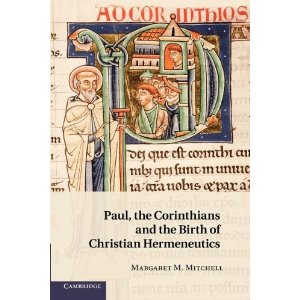Whatever else one might want to say, Margaret Mitchell (no not the one from Atlanta who wrote Gone with the Wind) can really write. Ruminate on the following paragraph (found on p. 5 of her recent monograph):
“Though he denies his power as a wordsmith, Paul does later from a distance claim metaphorical distinction as a ‘wise master-builder’…Without the self-effacement he used earlier, in ch. 3, when comparing himself with Apollos (and perhaps Cephas), Paul is adamant that he was their founder: he was the one who, like a wise master builder, laid the foundation– the only foundation that could be laid: Jesus Christ crucified. And yet as the letter proceeds we learn that the foundation itself is set in words; it lies on a scriptural subfloor without which Jesus Christ crucified would be an unmarked grave under an undeveloped subplot. Paul was the first Christian lexicographer, crafting a language for these Gentile Jesus-spirit-infused people around the Mediterranean basin in the first century. But he worked also to move those terms into sentences and paragraphs. He was the first Christian grammarian and rhetorician, as he styled himself, the teacher who moved children to adulthood (1 Cor. 3.1-4) as master-builder he crafted exegetical arguments to support the astonishing narrative of how Jesus was crucified and raised according to the will of God. The diction gravitates between longhand and shorthand, the rhetoric between appeals of dazzling clarity and tantalizing obscurity. In uncommonly long, personal, semi-public letters to the assemblies he founded, Paul expounded and re-expounded the gospel and the story of its reception, a history being created in the very moment of its telling; at other times— indeed, near the end of the tortured interchanges with Corinth– Paul would compress the whole involved message into the smallest imaginable proportions–a three letter, monosyllabic Greek word NAI! Jesus, Paul said, as known through his logos, was God’s cosmic YES (2 Cor. 1.19-20). No more words needed. Paul says, in hermeneutical fatigue, but a divine cosmic monosyllable, to which the fit human response (as Paul’s libretto scores it) is equally concise: ‘Amen’!”
Margaret’s chief concern in this book is to demonstrate not merely that Paul was the source of later hermeneutical reflections and method in the church, but also that Paul did not set out to lay down any one particular interpretative method. She puts it this way:
“As a thinker with apocalyptic start up software, Paul was inextricably caught between the poles of clear and unclear, the revealed and the conceiled [what she calls the veil scale], the known and the unknown. His hermeneutical claims in individual arguments (always very specific) gravitated to one pole or the other, depending upon the context, depending on the audience, depending upon the stakes. But mostly they veered and hovered, like the famous veil of 2 Corinthians 3 that both reveals and conceals,and moves from one conversation partner to another, somewhere between the two, and even suspended over the text, making communication possible, but always contested, fraught and questioned, partial and subject to ongoing revision and revelation. …Paul’s letters do not and never did have a single, unambiguous meaning. Even in his own lifetime, Paul’s letters— that most dynamic of genres– were disputed, his meaning contested, and negotiated in the history of the ongoing relationship within which the letters were situated. In the process of negotiating his own meaning— of prior letters,oral statements, idiosyncratic and potentially self contradictory behaviors– Paul made recourse to rhetorical topoi that justify the movement from text to sense, from the surface to the depths, from visible to the invisible.This is why the Corinthian correspondence is in a real sense the birth of Pauline hermeneutics–because only here in the extant remains of Paul’s letters can we see the process of writing, reading, rewriting, renegotiating, words and reality unfold before our very eyes.”
As an illustration of her point, she singles out 1 Cor. 5.9 where Paul refers to a, now lost, letter he previously wrote to the Corinthians in which he wrote them ‘do not associate with sexually immoral persons’. Now that sort of dictum could readily be taken to me– ever, in any circumstances, whoever they may be’. Indeed, it is precisely that sort of reading of 2 Cor. 6.14-7.1 that led groups like the Amish to basically withdraw from the world and indeed even to shun their own members who behalf in said manner. Paul however now explains in 1 Cor. 5.10– “not at all meaning the immoral of this world…since you would then need to go out of the world. But now I am writing to you not to associate with anyone who bears the name of brother or sister who is sexually immoral….’ So, after all Paul meant shunning believers, not avoiding pagans who behalf that way.
But Margaret’s point is well taken– as a dictum, 1 Cor. 5.9 could not be universalized. Paul had to come back and say— ‘no, no, I didn’t mean that.’ A literal globalizing interpretation of specific utterances of Paul’s often leads to misinterpretation of his actual meaning, as this example shows, or say the more famous ‘I am not now permitting them to teach…’ saying about women.













